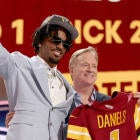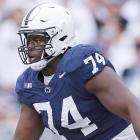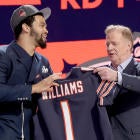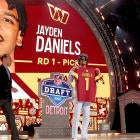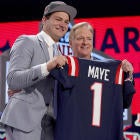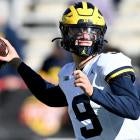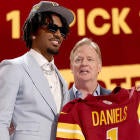Sam Bradford's six-year contract worth a maximum of $86 million that he signed as a rookie in 2010 set an NFL record with $50 million in guaranteed money. Bradford made slightly over $78 million during those six years, although he missed a season and half worth of games because of two ACL tears in his left knee.
The 2011 collective bargaining agreement drastically reduced salaries for early first-round picks by implementing a rookie wage scale. As the top pick in 2011, Cam Newton signed a fully guaranteed four-year, $22,025,498 deal, which included a $14,518,544 signing bonus. Deals for first-round picks under the rookie wage scale include an option for a fifth year. This salary for top-10 picks is the transition tag at a player's position when the option is exercised, which was $14.666 million in Newton's case. Potentially making slightly under $37 million over five years was a far cry from six-year contract that would have likely had a base value in the $86 million neighborhood with a maximum of approximately $95 million (in which $55 million would have been guaranteed) if the system hadn't changed.
Prior to the 2011 CBA putting the rookie wage scale in place, the old system of compensating rookies limited the amount of money teams could spend on draft picks and undrafted rookies. It didn't place an absolute ceiling on rookie contracts or provide specific financial guidelines for each draft pick.
Early first-round picks exploited the system primarily with salary escalators and not-likely-to-be-earned incentives which created lucrative base values for their deals. Additional money could also be earned with extraordinary achievements (All-Pro and Pro Bowl selections, leading the NFL in a particular statistical category, MVP, Defensive Player of the Year, Super Bowl MVP, etc.). The salaries of top picks skyrocketed because of these loopholes.
Unproven commodities were paid like Pro Bowlers without playing an NFL game. Jake Long, the 2008 first overall pick, became the NFL's highest-paid offensive lineman when he signed a five-year contract worth a maximum of $57.75 million containing $30 million guaranteed with the Dolphins. JaMarcus Russell, the top pick in 2007 who is widely considered as one of the biggest draft mistakes in NFL history, became the poster boy for the problems with the system. Russell made $39.365 million during three disappointing years with the Raiders. He never played in the NFL again after Oakland released him in 2010.
Change the way you listen to NFL news, subscribe to the Pick Six Podcast with Will Brinson and you'll be the most informed fan at your NFL Draft party. Subscribe: via iTunes | via Stitcher | via TuneIn
The NFL has been dramatically altered because of the financial ramifications of the rookie wage scale. Three areas where the impact has been clearly felt are draft trades, negotiating leverage for top picks during the latter part of rookie contracts and the escalation of salaries in the veteran market.
Draft trades
Selecting near the top of the NFL draft was a blessing and a curse prior to the rookie wage scale. It created an opportunity to get an impact player that could help change a team's fortunes. However, the salaries associated with top picks limited draft maneuverability. Nobody was clamoring to pay a king's ransom in draft choices to move up to the top portion of the first round knowing the type of contract that was going to be required for the player.
Only one trade from outside for the top five of the draft into the top five picks was made during the last five years of the old system. That was in 2009, when the Jets moved from 17th to fifth to select quarterback Mark Sanchez.
Trading for top picks has been become a fairly common occurrence under the rookie wage scale. It's happened seven times since 2011. There could still be more such trades before the first round of this year's NFL draft is selected on April 26. The quarterback-needy Bills, who have the 12th and 22nd overall picks, are considered the most likely candidate to move into the top five in a top-heavy quarterback draft.
The Redskins gave the Rams multiple selections, including two first-round picks, to move from sixth to second in 2012 to take Heisman Trophy winner Robert Griffin III. The decision to make the trade -- or at least the amount of draft-choice compensation the Redskins were willing to part with -- may have been different with the type of contract that would have been necessary for Griffin pre-rookie wage scale. Instead of a fully guaranteed four-year contract for just under $21.12 million, Griffin probably would have gotten a six-year deal with a base value of at least $84 million and more than $90 million as the maximum, and $52.5 million of his deal may have been fully guaranteed.
We'll never know whether Griffin's contract may have kept him in the starting lineup at the beginning of the 2015 season, when he lost his job to Kirk Cousins, assuming the Redskins would have still made the trade to get him at a much higher financial cost. If so, Cousins' ability to become the NFL's highest-paid player may have been compromised without the chance to develop into a promising starting quarterback, as he did during his contract year in 2015.
The Rams and Eagles traded up to the first and second spots of the 2016 draft to select quarterbacks Jared Goff and Carson Wentz, respectively. If top-draft-pick contracts had continued increasing at a similar rate as before the rookie wage scale, $110 million over six years as the base value of these deals, with $70 million fully guaranteed where the maximum value is close to $125 million, wouldn't have been out of the question
The annual growth rate with these contracts was pretty substantial. Bradford received an 8.3 percent increase over the base value of 2009 first-overall pick Matthew Stafford's six-year, $72 million deal and a 10.3 percent increase over Stafford's $78 million maximum. His $50 million guaranteed was almost a 20 percent increase over the $41.7 million of guaranteed money Stafford received a year earlier.
The tremendous roster-building advantage Philadelphia has with Wentz on an extremely affordable rookie contract would have been negated if his first contract averaged over $18 million per year instead of currently being just under $6.7 million per year. Super Bowl LII MVP Nick Foles, one of the NFL's higher-priced backup quarterbacks, may have been a luxury Eagles executive vice president of football operations Howie Roseman couldn't afford. Some of Philadelphia's depth in the trenches on both sides of the ball, which played a role in winning last season's Super Bowl, probably gets compromised with Roseman constructing the salary cap to accommodate Foles.
This year's first overall pick, presumably a quarterback, may have expected a six-year contract with a base value of $130 million where $85 million or more fully guaranteed from the Browns, given how rookie contracts had been escalating at the top of the draft. The maximum value for the six years could have been as much as $145 million.
It's debatable whether the Giants will take a quarterback with the second overall pick. A quarterback would have been out of the question under the old system, with the Giants committed to Eli Manning in 2018 because of his $21 million-per-year contract while a rookie passer would have gotten a deal averaging just about the same. The Giants could have been caught between a rock and a hard place by wanting to go the rebuilding route with a young quarterback unless Manning would have been willing to waive his no-trade clause.
Negotiating leverage
Before the 2011 draft, the latter years of these rookie contracts typically became unmanageable for teams when the draft picks were highly productive because of astronomical cap numbers from earning close to the maximum value. Some teams, like the Lions, would compound the problem by restructuring rookie contracts for immediate cap relief, which would raise the cap numbers in remaining years.
This practice led to immense leverage for the player where the extremely large cap numbers forced a team to reset a positional market on an extension with a player-friendly structure, or let him become an unrestricted free agent once his rookie contract expired, as the Lions did with defensive tackle Ndamukong Suh, because use of a franchise tag was impractical. For example, the Lions made wide receiver Calvin Johnson, the second overall pick in 2007 NFL Draft, the NFL's highest-paid non-quarterback on a seven-year, $113.45 million extension in 2012 where $53.25 million was fully guaranteed at signing. It would have been virtually impossible for the Lions to franchise Johnson at over $25 million when his rookie contract expired after the season and lowering his 2012 salary-cap number, which was slightly over $21 million, was a necessity.
The elimination of this phenomenon under the rookie wage scale has helped restrict the salaries of top players. The Panthers may have been facing a similar predicament with Newton as the Lions did with Johnson because of a challenging cap situation. It's conceivable that Newton's franchise tag when his contract expired after the 2016 season would have easily exceeded the 2016 exclusive quarterback number of $25.98 million since his figure probably would have based off 120 percent of his 2016 cap number. Newton's timing for an extension wouldn't have come at a better time for him, since it would've been right after winning league MVP and a Super Bowl appearance. This likely would've given Newton the leverage for a long-term deal averaging more than $25 million per year with over $70 million in guarantees two years before Raiders quarterback Derek Carr became the NFL's first $25 million-per-year player last offseason.
Three-time All-Pro Von Miller is another perfect illustration of this concept. The base value of Miller's five-year deal would have been $62 million to $65 million and the maximum in the $70 million range without the rookie wage scale. Miller has approximately $42 million fully guaranteed. He would've become the NFL's second-highest paid linebacker in 2011 with his rookie contract. These values are consistent with differences in guarantees with Bradford and 2010 second pick Suh's deal.
The Broncos might have been comfortable letting Miller play out his rookie contract because of the six-game suspension he served in 2013 for violating the NFL's substance-abuse policy. Based on Suh's cap number in the final year of his rookie deal prior to contract restructures, Miller's 2015 cap figure would have been approaching $16 million. His 2016 franchise-tag number would have been over $19 million instead of slightly above $14 million like it actually was.
The higher franchise number along with a Super Bowl 50 MVP performance gives Miller enough ammunition to become the NFL's first $20 million-per-year non-quarterback, which has yet to occur. Because a second franchise tag in 2017 would have been right around $23 million, Miller's deal is probably in the $21 million-per-year neighborhood. That's using the average of two franchise tags, like any competent agent would insist upon Denver doing in a long-term deal.
A better deal for Miller becomes a salary floor for 2014 first-round picks Khalil Mack and Aaron Donald, the game's best two young defensive players. Both are in their contract years, which would have been the case regardless of the rookie system in place. Donald, the 13th overall pick, isn't nearly as affected by the changes with rookie deals as Mack, who was the fifth-overall pick.
Mack's five-year rookie contract likely has a maximum value close to $70 million, which he probably would have earned given he is a perennial All-Pro and was 2016's NFL Defensive Player of the Year. His 2018 cap number in his contract year would be significantly more than his scheduled $13.846 million fifth-year option. Any long-term deal Mack signed under these circumstances might average closer to $25 million per year than $20 million per year.
Veteran market salary escalation
The system of slotting salaries according to where a player was taken in the draft didn't take position into consideration for contract values. There was one exception before the rookie wage scale: Quarterbacks were given a premium no matter where they taken in the early rounds of the draft.
Running-back salaries would be completely different provided the actual selections over the years would have remained the same without the rookie wage scale being created. Trent Richardson becomes the cautionary tale for using a top pick on a running back. As the third pick in the 2012 draft, the base value of his five-year rookie deal would've been in the $60 million neighborhood. The maximum value would've been over $65 million. He would've set a new standard for guaranteed money for running backs, topping the $36 million Adrian Peterson received in his 2011 extension. Richardson's deal would've made him the NFL's third-highest-paid running back behind Peterson and Chris Johnson. The trade to the Colts shortly after the 2013 regular season started never would've happened, because the Browns wouldn't have found any takers for a high-priced Richardson.
Ezekiel Elliott's rookie contract with the Cowboys in 2016 as the fourth-overall pick would've put him at the top of the running-back salary hierarchy. The base value of his five-year deal would've been more than $15 million per year with over $50 million guaranteed, with the maximum value in excess of $80 million. Leonard Fournette going in the exact same spot in the draft last year probably would've gotten a deal with base value averaging $16 million or more per year. Saquon Barkley is a potential second pick in this year's draft if the Giants remain in that spot. A five-year deal for Barkley could have averaged close to $19 million where the maximum value would have exceeded $100 million. The guarantees would have topped easily topped $60 million.
The slotting of rookie deals and the veteran contracts were two distinct markets. The exorbitant contracts that unproven talents received before playing a down in the NFL were considered fair game by agents in the negotiations of accomplished veterans. The $15 million per year Le'Veon Bell, arguably the NFL's best dual threat running back, reportedly wanted last year after the Steelers designated him as a franchise player would have seemed a lot more reasonable with Elliott and Fournette's rookie contracts setting the running-back market. The existence of these contracts likely would have put Bell's demands in the same ballpark in 2017 as the $17 million per year he wants this year, according to the NFL Network, after getting franchised a second time.













